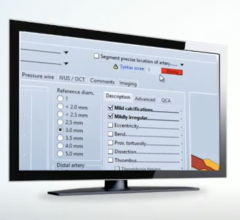Measuring the benefits against the risks (and costs) is an integral component of a sound business plan and will assist in the design, development and deployment of a successful cardiovascular information system (CVIS) strategy.
As with any clinical IT system implementation, either new or a replacement, there is a risk with user acceptance/adoption challenges and a possible failed implementation. Any change to the current environment will create unease among the physicians’ work force, which ultimately stirs in the mahogany halls of administration. For these reasons, it is important to perform a careful and detailed analysis of the department’s current state and long-term organizational requirements to determine the most feasible product must be conducted. The scope and process must ensure the system selected will have an acute initial impact to ongoing operations, yet, deliver the intended results. Although there are multiple products and vendors available, the system will likely fail to serve the intended purpose and scope, unless a codified outcome and process are utilized.
In addition to procuring an effective solution, the implementation methodology and actual transition to a new CVIS will have a significant impact on the staff and the organization as a whole. Careful implementation planning will determine the least disruptive methodology, establish early buy-in from the leadership for the entire project lifecycle, and an adoption model that provides adequate training and support for clinicians to improve patient care and outcomes.
Costs and Transitional Considerations
In order to successfully prepare the capital for the CVIS procurement, the organization must be aware and codify their immediate and future strategic requirements with an eye towards the enterprise. A CVIS is comprised of many components, some of which can be purchased upfront with the remainder left for later phases as capital becomes available and organizational requirements mature. Depending on the size of the budget, an organization may initially choose to implement the cardiology picture archiving and communication system (cardiac PACS or CPACS), then slowly implement other CVIS components as applicable, based on the deployment strategy and priority levels determined during the planning phase.
Some vendors offer an entire CVIS solution in a single platform, including a native and integrated hemodynamic system, ECG modules and other cardiology components. If your organization has recently procured an enterprise hemodynamics or ECG system, it may not be feasible to procure the entire CVIS offering. All products offered should be reviewed and procured only if there is a truly clinical benefit and a viable return on investment. Since the majority of CVIS vendors have worked to establish very sound interfaces with third-party systems, the customer may choose not to procure the complete package upfront, but have the new CVIS interface with only their existing devices and systems.
Additional cost considerations include storage and network design. The storage system will require a close collaboration between cardiac imaging and IT. Sites need to understand their cardiac imaging volume, how long they want to retain data, and how quickly physicians need to be able to retrieve data, and select a storage infrastructure to meet those requirements. In addition, facilities will need to address network bandwidth to ensure images will launch at an appropriate speed for their end users.
A key area for potential cost savings is early legacy data migration. Clinical workflow has always driven the need to have historic exams available for comparison with the current study. An organization should not overlook this requirement and capital dollars should be allocated to complete early migration of legacy data to the new CPACS/CVIS or consider taking advantage of early imaging consolidation for all departments (“ologies”) utilizing an enterprise vendor neutral archive (VNA).
Transitional Methodology
As with any other project, a CVIS will require a governing steering committee for strategy development and roll-out. That committee should include senior leadership from the physician community, directors/administrators and IT professionals. A series of clinical, technical, and fiscal decisions will occur throughout this initiative, thus, a diversified and well informed committee is essential to the success. This should not be considered just another IT or clinical project; collaboration is critical throughout the procurement and implementation to ensure that limited conflict arises from cross-functional groups and, if issues rise, they can be quickly escalated and addressed.
Contrary to a single entity, an integrated delivery network (IDN) may face standardization challenges across the enterprise with ordering, billing, inventory and report modules; therefore, having a single committee to make the decision is critical. Early leadership and physician buy-in is also tremendously essential to empower the appointed project management team to drive healthy momentum and product adoption.
Current State Assessment
Prior to any procurement of an enterprise system, an organization should thoroughly assess their clinical and technical areas to develop a definitive list of requirements. Knowing the current state of needs and having a clear understanding of where the enterprise needs to go, the procurement, and the contract process will eliminate unnecessary loss of capital. You do not want to purchase a system then have to negotiate workflow later. Furthermore, understanding the organization’s existing systems and their ability to integrate/interface with the market-available /CVIS vendors will allow for more accurate technical design and cost projections. More often than not, an organization will have change orders submitted in the course of project implementation due to system limitations that may be discovered in the eleventh-hour. For example, the majority of an organization’s physician workflow is driven by the electronic medical record (EMR), so understanding all interfaces for admission, discharge and transfer (ADT), orders, results and image enablement will allow for more accurate planning.
RFP and Procurement
The request for proposal (RFP) allows an organization to compare several systems and vendors that closely meet the organizational needs. Trying to negotiate with a single vendor has never been a strong position. There are a variety of systems in the market that from a marketing perspective boast the same functionality. Placing them next to each other will allow the steering committee to clearly differentiate each one in relation to user experience, functional disparities as well as cost. Often this component of the process is given the least amount of attention, but when addressed correctly can give the CVIS stakeholders significant insight into the feature/benefits of competing solutions. Additionally, a sophisticated RFP process can rapidly advance the decision making process, assist in pricing negotiations and expedite the contractual language for master products and service agreement (MPSA).
Implementation
A successful CVIS implementation is typically the result of comprehensive and well documented planning. The planning committee should consist of vendor and customer teams. Most likely, the vendor of choice has implemented their product in a similar organization, replicating the project plan as a baseline with the estimated timeline, which is never a bad concept. The beauty of contracting with a well-established vendor and system is you are not their first customer — in most cases. Keep in mind that does not ensure the delivery is bullet proof. Every completed project brings with it a list of “lessons learned” and should always be referenced prior to project plan completion. Consider reviewing those documents and discoveries to avoid making similar mistakes within your enterprise.
Experiences have shown that organizations like to duplicate successful implementation methodologies. For example, duplicating a radiology PACS/RIS (radiology information system) implementation with a CVIS implementation may not be the safest route. Cardiology modalities, reporting and workflow are significantly different from radiology; therefore, the methodologies should be assessed prior to execution.
Implementation of any new system will cause a natural change in the organization. A good change is healthy for growing healthcare, but is difficult to manage. A master project plan needs to include a list of possible change risks with mitigation options and contingencies should they occur. Early buy-in from the leadership and physician champions is crucial in decreasing the possibility of user resistance due to the change. Leadership that signals their buy-in and support prior to the project will encourage the remaining staff to follow and adopt.
CPACS/CVIS Market
The CVIS market is reaching a maturity level, making it a great time for organizations to begin their strategy developments and procurements. A large selection of vendors in the market now provide a good mix of competition. Today, we see a number of reliable companies offering similar products tightly integrated for a seamless system performance. These vendors are eager to negotiate and are willing to work with the customer.
The cardiology community is also becoming more involved in the imaging market and the vendors are beginning to respond to the customer’s needs. This is a good time in the market to begin researching available systems to see how each one may fit your organization’s needs in the near future. It is important to review the core components of the product to see where the vendor is heading: Are they integrating with third-party vendors (never a native integration) or are they designing their own product code? These questions are a good starting point and raise a discussion around the company’s ability to grow in their product roadmap in the ever-changing industry.
Editor’s note: Val Kapitula, RT(R), CRT, PMP, and Jen Ireland are senior consultants at Ascendian Healthcare Consulting. Both are frequent contributors to publications and forums focused on HIT innovation. You may contact them directly at [email protected] and [email protected], or visit the Ascendian website for more information at www.ascendian.com.



 June 27, 2022
June 27, 2022 








